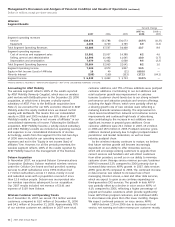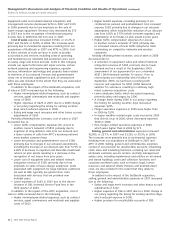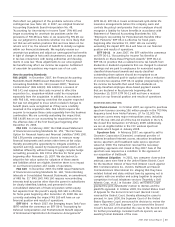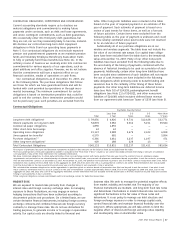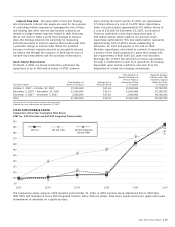AT&T Uverse 2007 Annual Report Download - page 41
Download and view the complete annual report
Please find page 41 of the 2007 AT&T Uverse annual report below. You can navigate through the pages in the report by either clicking on the pages listed below, or by using the keyword search tool below to find specific information within the annual report.
2007 AT&T Annual Report
| 39
monitor these systems. In these market expansions, we expect
to continue to use contracted outside labor in addition to our
employees as installers; our rate of expansion will be slowed
if we cannot hire and train an adequate number of qualified
contractors and technicians to keep pace with customer
demand or if we cannot obtain all required local building
permits in a timely fashion. We also continue to work with
our vendors on improving, in a timely manner, the requisite
hardware and software technology. Our deployment plans
could be delayed if we do not receive required equipment and
software on schedule. See our “Liquidity & Capital Resources”
discussion for an update on our U-verse capital spending.
We believe that our U-verse TV service is subject to federal
oversight as a “video service” under the Federal Communi-
cations Act. However, some cable providers and municipalities
have claimed that certain IP services should be treated
as a traditional cable service and therefore subject to the
applicable state and local cable regulation. Certain
municipalities have refused us permission to use our existing
right-of-ways to deploy or activate our U-verse-related
services and products, resulting in litigation. Pending
negotiations and current or threatened litigation involving
municipalities could delay our deployment plans in those
areas. If the courts having jurisdiction where we have
significant deployments of our U-verse services were to
decide that federal, state and/or local cable regulation
were applicable to our U-verse services, it could have a
material adverse effect on the cost, timing and extent of
our deployment plans.
REGULATORY DEVELOPMENTS
Set forth below is a summary of the most significant develop-
ments in our regulatory environment during 2007. While these
issues, for the most part, apply only to certain subsidiaries in
our wireline segment, the words “we,” “AT&T” and “our” are
used to simplify the discussion. The following discussions are
intended as a condensed summary of the issues rather than
as a precise legal description of all of those specific issues.
International Regulation Our subsidiaries operating
outside the U.S. are subject to the jurisdiction of regulatory
authorities in the market where service is provided. Our
licensing, compliance and advocacy initiatives in foreign
countries primarily enable the provision of enterprise
(i.e., large business) services. AT&T is engaged in multiple
efforts with foreign regulators to open markets to
competition, reduce network costs and increase our
scope of fully authorized network services and products.
Federal Regulation A summary of significant 2007 federal
regulatory developments follows.
Wireless
Wireless Broadband Order In March 2007, the FCC adopted
a declaratory ruling stating that wireless broadband Internet
access services are information services. The FCC’s decision
thus places wireless broadband Internet access service on
the same largely-deregulated footing as cable and wireline
broadband services.
Order on Recommendations of the Hurricane Katrina
Panel In October 2007, the FCC issued an order revising its
previously adopted rule that was designed to improve the
reliability, interoperability and recovery of telecommunications
in future disasters. The original order required carriers to
maintain backup power, for a specified number of hours, at
certain points in the network, such as cell sites and remote
terminals. The FCC revised the backup power rule due to
numerous concerns raised by providers about feasibility of
compliance with the original rule. Although compliance with
the new rule will still require substantial effort by AT&T, it
gives us additional flexibility to meet our backup power
obligations by gauging compliance with reference to the
original design parameters of assets, exempting assets from
the backup power requirements where compliance is
infeasible and permitting us to satisfy our obligations by
creating a disaster recovery plan that relies on portable
generators and other backup power sources.
E911 Order In September 2007, the FCC adopted an
order (the E911 Order) that would substantially increase
accuracy requirements in connection with providing the
location of a caller to 911 to dispatchers of emergency
services. The E911 Order will become effective in April 2008.
Under FCC rules, carriers are required to attempt to deliver
location data to Public Safety Answering Points (PSAPs)
when callers dial 911. We use a network-based location
solution that employs triangulation to estimate the location
of the caller. Location data for this network-based solution
must be accurate within 300 meters on 95 percent of all
calls and within 100 meters on 67 percent of all calls.
The current rules permit these percentages to be calculated
based on all calls, network-wide, for purposes of measuring
location accuracy. The E911 Order would require wireless
carriers to achieve E911 location accuracy measured in
each of the local areas served by the approximately 6,000
PSAPs across the country. Carriers would have until
September 2012 to achieve PSAP-level accuracy, and would
have to demonstrate compliance with certain incremental
location accuracy benchmarks in 2008 and 2010. The
PSAP-level accuracy requirement in the E911 Order is not
attainable throughout our wireless network using currently
available commercial technology.
We are considering all avenues for review of the E911 Order,
including through an appeal or a petition for reconsideration.
Depending on technological developments, the interpretation
of the final order and the resolution of any appeals, we could
be required to make significant capital expenditures to
implement and maintain compliance with this order.
Wireless Universal Service Our wireless subsidiary, AT&T
Mobility, is currently an Eligible Telecommunications Carrier
(ETC) for purposes of receiving federal universal service
support in certain states. To maintain these designations, the
state must certify that the carrier is entitled to receive the
funds for the subsequent calendar year based on federal and
applicable state ETC requirements. We are certified for each
relevant state for 2008. In May 2007, the Federal-State Joint
Board on Universal Service recommended applying a funding
cap to the amount of universal service support received by
competitive ETCs. Moreover, in order to obtain approval for
our acquisition of Dobson, we agreed to a voluntary cap on
our receipt of federal universal service high-cost support.
The cap will be set at the amount of wireless universal
service support we received as of June 30, 2007, which was
approximately $225. Additionally, the FCC is considering an



